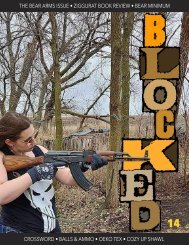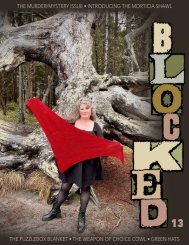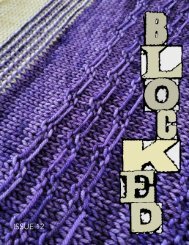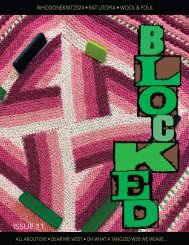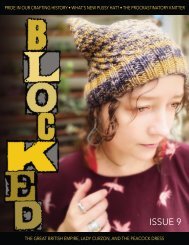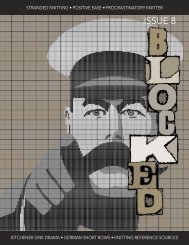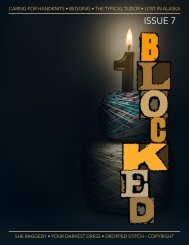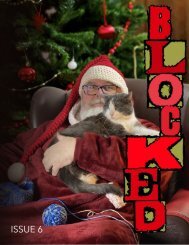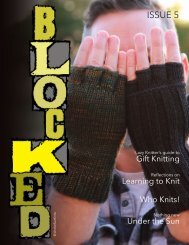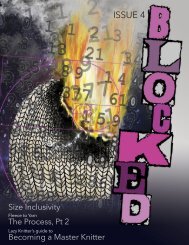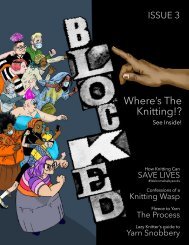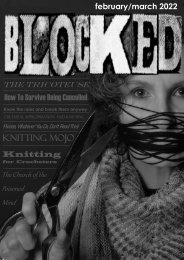blocked_10_final
Create successful ePaper yourself
Turn your PDF publications into a flip-book with our unique Google optimized e-Paper software.
SQUARE SHAPED<br />
SHAWLS<br />
By Uknitted Kingdom<br />
In the first of a new series of “recipes” we’ll be<br />
showing you how to create basic shawl shapes.<br />
These will not necessarily include row by row instructions,<br />
but brief directions about where to increase<br />
and decrease to obtain a particular shape.<br />
Use any yarn with needles appropriate for the<br />
drape you prefer.<br />
Increases and decreases:<br />
Use whichever increase and decrease methods<br />
you prefer.<br />
For a symmetrical appearance use mirrored increases<br />
and decreases.<br />
Generally, you will be able to move the placement<br />
of any increase or decrease to the left or to the<br />
right by a couple of stitches and still achieve the<br />
same shape. Many designers choose to use increases<br />
and decreases on the inside of a simple or patterned<br />
selvedge, or garter or I-cord edging. For example,<br />
you may choose to knit 3 stitches in garter before<br />
making your right-hand increase or decrease, and 3<br />
stitches in garter after making left hand increase or<br />
decrease.<br />
Using yarn overs creates a<br />
decorative increase. However, if<br />
you want the decreases to match<br />
you will have to use a yarn over<br />
preceded or followed by a decrease.<br />
Any of these recipes could be<br />
used to create a blanket, either<br />
smaller squares joined together,<br />
or one large square.<br />
The simplest of all methods is<br />
the basic garter stitch square.<br />
For a square without any<br />
increases or decreases:<br />
Cast on the desired number<br />
of stitches and knit in garter stitch<br />
until the length matches the<br />
width.<br />
For a square shaped diagonally:<br />
Cast on 1 stitch.<br />
Increase at the beginning of every row in garter<br />
stitch until the desired width is reached.<br />
Bind off when the square is the required size.<br />
Decrease at the end of each row in garter stitch<br />
until you have only one stitch left.<br />
These 2 recipes form the center of traditional hap<br />
designs.<br />
For a mitered square:<br />
Cast on an odd number of stitches. This will be<br />
the bottom two edges of your diagonally shaped<br />
square.<br />
Make a central double decrease using the center<br />
3 stitches on every other row, continue in garter stitch<br />
until the last 3 stitches and tie off with a central double<br />
decrease.<br />
An example of this square is shown in more detail<br />
in the “Golden Ratio Cowl” on page 15.<br />
Or Cast on an even number of<br />
stitches. Place a marker in the center of<br />
the stitches.<br />
On every row of garter stitch, knit<br />
until two stitches before the marker.<br />
Make a single decrease, SM, knit to the<br />
end of row.<br />
When you are left with the <strong>final</strong> 2<br />
stitches, knit them together to bind off.<br />
Or:<br />
Cast on 1 stitch. Increase by 2 stitches<br />
(3 sts in total). Place a marker on either<br />
side of the center stitch.<br />
RS rows: Knit to marker, increase, slip<br />
marker, k1, slip marker, increase, knit to<br />
end of row<br />
WS rows: Knit<br />
Bind off when the square is the required<br />
size.<br />
For center-out squares:<br />
Center-out squares are knitting inthe-round,<br />
and therefore well suited to<br />
stockinette stitch patterns.<br />
38





